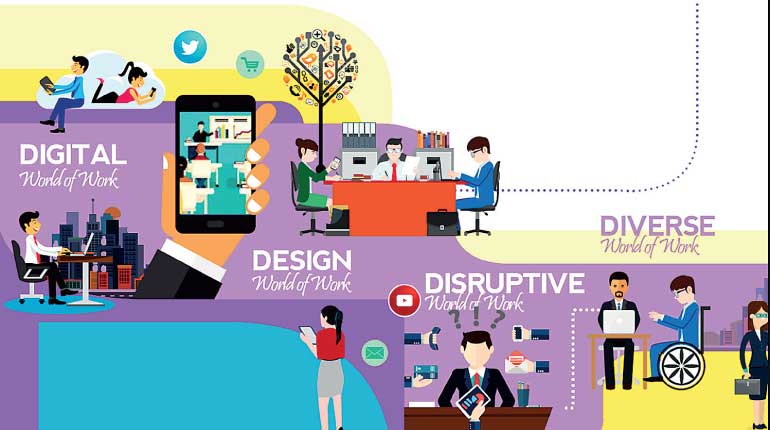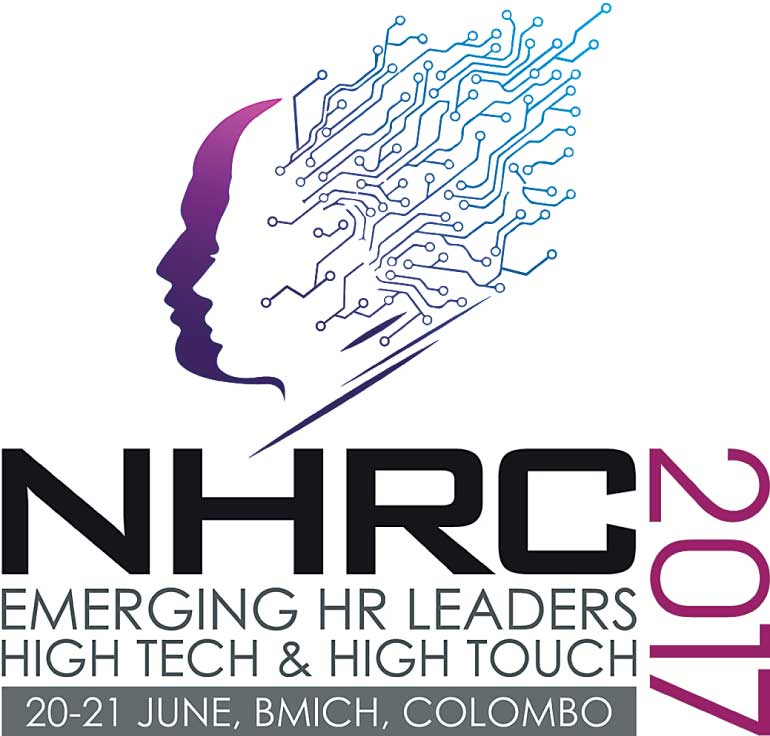Friday Dec 26, 2025
Friday Dec 26, 2025
Monday, 5 June 2017 00:00 - - {{hitsCtrl.values.hits}}
The National Human Resource Conference (NHRC) of 2017, the largest HR Conference in South Asia is round the corner. Whilst we are recovering from a huge human tragedy that is only second to the tsunami, the focus is on being humane in uplifting human lives. This column and the next will highlight the nature and features of NHRC 2017 in inviting the Daily FT readership to enjoy an insightful and interactive experience.

Overview
I am delighted to drive a dynamic community of diverse people in presenting a distinctly different experience at the NHRC 2017. We have aptly selected the theme: ‘Emerging HR Leaders: High Tech and High Touch’. We will deliberate on digitalisation, disruption, diversity and design with regard to this inspirational intervention.
At a time when we are increasingly challenged by a multi-cultural, multi-generational and multi-skilled workforce, the role of HR professionals is becoming increasingly critical. They have to think and act as leaders and not as laggards. Such emerging HR leaders have to be “tech-savvy” in reaping the dividends of digitalisation, on one hand. On the other hand, they have to be “touch- savvy” in recognising the emotions of engaged employees. Thus, the challenging balance between high tech and high touch is right in front of the HR leaders. They have to be authentic in producing value by practicing values in such an enormous endeavour.
savvy” in recognising the emotions of engaged employees. Thus, the challenging balance between high tech and high touch is right in front of the HR leaders. They have to be authentic in producing value by practicing values in such an enormous endeavour.
As we are aware, HR leaders are very high in demand. It is much easy to do your bit and to be an isolated individual. Yet, the current times demand HR professionals to demonstrate the leader within. It, in essence, boils down to influencing, inspiring and instructing, with a tough mind and a tender heart, in ensuing right results and relationships. That’s the sure fire way to be at the top and not at the tap. This is the context, in which the Institute of Personnel Management (IPM) Sri Lanka, being the national leader in HR has decided to focus on this year’s national HR conference to reflect on and relate to its obligations to the nation, in grooming HR leaders.
Ironically, we have an over-emphasis on private sector HR with less focus on public sector. This should be rectified through a sensible dialog on best HR practices and their applicability to both private and public sectors alike. HR can be a bridge between private and public sectors as its key functions have an overarching effect on utilising the most precious resource of any organisation. National HR Conference (NHRC 2017) intends to fill this void in a meaningful and memorable manner.
Technology as a key driver
Technology has always been an enhancer of our work. From adding machine to the advanced computer this was the case. Digitalisation has become a wave spreading across the world, revealing multiple varieties. This power to unveil not only transforms human outreach and actions, but also changes our conceptions; about whom we are, about our uses and about human horizons for sense-making (Fors, 2010). According to www.gartner.com, digitalisation is the use of digital technologies to change a business model and provide new revenue and value-producing opportunities; it is the process of moving to a digital business.
“We are witnessing profound shifts across all industries, marked by the emergence of new business models, the disruption of incumbents and the reshaping of production, consumption, transportation and delivery systems” observes Schwab (2014), in his most recent book, ‘Fourth Industrial Revolution’.
As he further explains: “We have yet to grasp fully the speed and breadth of this new revolution. Consider the unlimited possibilities of having billions of people connected by mobile devices, giving rise to unprecedented processing power, storage capabilities and knowledge access. Or think about the staggering confluence of emerging technology breakthroughs, covering wide-ranging fields such as artificial intelligence (AI), robotics, the internet of things (IoT), autonomous vehicles, 3D printing, nanotechnology, biotechnology, materials science, energy storage and quantum computing, to name a few.” (Schwab, 2014: 1)
Obviously the relevance of digitisation to Sri Lankan organisations is beyond doubt. In essence, the digital business transformation (DBT) is the conversion of operations from the industrial age to the information age. According to Jonston (2001), the model for creating business value has changed. Organisations today participate in extended supply chains, where real operational efficiency and revenue enhancement come from greater visibility, integration, and synchronisation among connected partners.
The DBT leadership challenge is about re-energising businesses that may already be successful to capture the full potential of information technology across the total supply chain. In essence, DBT is the conversion of business operations from Industrial-Age to Information-Age technology. It’s about reinventing and positioning business operations, processes, and relationships to fully exploit information technology.
People barriers for progress
As Bowerzox (2007) observes, the greatest barriers to a digital transformation are not technical or legal. Rather, they relate to prevailing managerial and employee attitudes, practices, and traditions around what constitutes best practice. Most acknowledged best practices were established decades ago using the technology then available to address problems or challenges that for the most part no longer exist. Actions that once were considered best practice are increasingly becoming unnecessary or obsolete. Yet it’s the perpetuation of these traditional practices that thwart significant breakthroughs toward new and more meaningful ways to work.
In order to overcome the people barriers, an organisation needs to understand the “hard” and “soft” aspects involved. In other words, two different and opposing elements appear to be in a constant state of flux. This is the nature of human resource management (HRM) in reality, where managing employee concerns as well as employer concerns need to take place in synergy and harmony.
The beauty of HRM is the meaningful co-existence of such a complex yet coherent whole. It is not only HR professionals but all other managers should be aware of such a harmony in order to maintain proper balance between achieving results and maintain relationships. This is increasingly becoming significant in the era of digitalisation.
From best practices to next practices
Digital business transformation is about significant change. It should be diligently driven by leadership. It is the ultimate challenge in change management because it impacts all organisational levels of an enterprise and its extended supply chain. The transformation starts with redefining the firm’s strategic vision—that is, the shared composite of goals, competencies, and capabilities a firm deploy to create and sustain competitive advantage.
At this early stage of the digital transformation, it’s clear that some organisations are having a tougher time getting started on the journey than others. For example it’s evident that A&P, Corning, Kodak, Motorola, Sears, and Xerox, to name a few, waited far too long to adapt to the digital imperative in both products and processes. Others, such as GM, Procter & Gamble, and IBM seem to be well on their way. In any case, one thing is clear: The digital business transformation is best initiated from a position of strength rather than weakness.

As Jonston and Whang (2002) point out, additional considerations in a seamless execution of DBT involve transitioning from traditional ideas about organisational structure. The traditional line-and-command, functionally focused organisational chart is replaced by an integrated supply chain structure built on shared values.
In order to have sustained digital business transformation, an organisation might need all of the four scenarios highlighted in the above model. However, charismatic transformation that includes a collaborative leadership style with a major scale of change would be the key requirement for sustained results.
As we have seen so far, one needs to be diligent in becoming digital. A comprehensive understanding on the key elements of the supply chain associated with one’s organisation is a must. Due consideration should be given to both hard and soft dimensions in managing people in ensuring an effective digital business transformation. It is heartening to see the Sri Lankan workplaces doing the ground work but overall, it is a long journey ahead.
Role for HR leaders
The context of technology is a clear invitation to HR leaders to influence the organisational thinking and actions through their words and deeds. It challenges them to be “tech-savvy” whilst being “touch-savvy” in maintaining harmony. The NHRC 2017 will shed lots of light in this direction with multiple knowledge sharing sessions.
We brought you “In Search of HR Excellence” in 2013 with an overwhelming success. We hosted the largest even attended HR event of IPM in 2014 with the theme, ‘Redefining HR for Boosting Performance’. It further expanded with the theme ‘HR for National Prosperity’ in 2015. Last year, we zoomed into the aspect of competing as a nation in a global scale with the fitting theme, ‘HR Ecosystem for Competitiveness’. Now, the South Asia’s largest HR event is coming to you, more enhanced and enriched on 20 and 21 June as an engaging and energising experience. I have no doubt that it will generate immense insights, initiatives and implications in line with emergent HR leaders being high tech and high touch.
(Prof. Ajantha Dharmasiri can be reached through [email protected], [email protected], [email protected] or www.ajanthadharmasiri.info)